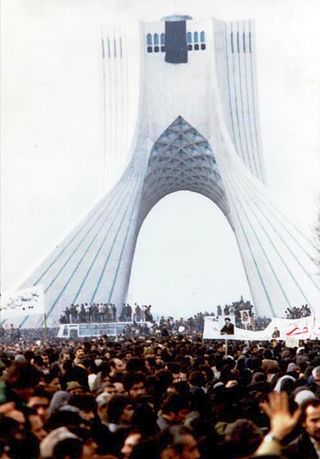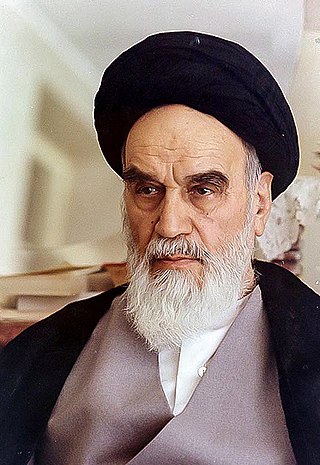
Ruhollah Musavi Khomeini was an Iranian Islamic revolutionary, politician, and religious leader who served as the first Supreme Leader of Iran from 1979 until his death in 1989. He was the founder of the Islamic Republic of Iran and the main leader of the Iranian Revolution, which overthrew Mohammad Reza Pahlavi and ended the Iranian monarchy.
The term Islamic republic has been used in different ways. Some Muslim religious leaders have used it as the name for a form of Islamic theocratic government enforcing sharia, or laws compatible with sharia. The term has also been used for a sovereign state taking a compromise position between a purely Islamic caliphate and a secular, nationalist republic.

The Iranian revolution, also known as the 1979 revolution, or the Islamic revolution of 1979 was a series of events that culminated in the overthrow of the Pahlavi dynasty in 1979. The revolution led to the replacement of the Imperial State of Iran by the present-day Islamic Republic of Iran, as the monarchical government of Mohammad Reza Pahlavi was superseded by the theocratic Ayatollah Ruhollah Khomeini, a religious cleric who had headed one of the rebel factions. The ousting of Pahlavi, the last Shah of Iran, formally marked the end of Iran's historical monarchy.

Black Friday is the name given to an incident occurring on 8 September 1978 in Iran, in which 64, or at least 100 people were shot dead and 205 injured by the Pahlavi military in Jaleh Square in Tehran. According to the military historian Spencer C. Tucker, 94 were killed on Black Friday, consisting of 64 protesters and 30 government security forces. The deaths were described as the pivotal event in the Iranian Revolution that ended any "hope for compromise" between the protest movement and the regime of Shah Mohammad Reza Pahlavi.

Ayatollah Mohammad Reza Mahdavi Kani was an Iranian Shia cleric, writer and conservative and principlist politician who was Prime Minister of Iran from 2 September until 29 October 1981. Before that, he was Minister of Interior in the cabinets of Mohammad-Ali Rajai and Mohammad-Javad Bahonar. He was the leader of Combatant Clergy Association and Chairman of the Assembly of Experts and also founder and president of Imam Sadiq University.

The national emblem of the Islamic Republic of Iran features four curves and a sword, surmounted by a shadda. The emblem was designed by Hamid Nadimi, and was officially approved by Ayatollah Ruhollah Khomeini, the first Supreme Leader of Iran, on 9 May 1980

Sayyid Mahmoud Alaei Taleghani was an Iranian theologian, Muslim reformer, democracy advocate, a senior Shia Islamic scholar and thinker of Iran, and a leader in his own right of the movement against Shah Mohammad Reza Pahlavi. A founding member of the Freedom Movement of Iran, he has been described as a representative of the tendency of many "Shia clerics to blend Shia with Marxist ideals in order to compete with leftist movements for youthful supporters" during the 1960s and 1970s. His "greatest influence" has been said to have been in "his teaching of Quranic exegesis," as many later revolutionaries were his students.

The demonstrations of June 5 and 6, also called the events of June 1963 or the 15 Khordad uprising, were protests in Iran against the arrest of Grand Ayatollah Ruhollah Khomeini after his denouncement of Iranian Shah Mohammad Reza Pahlavi and Israel. The Shah's regime was taken by surprise by the massive public demonstrations of support, and although these were crushed within days by the police and military, the events established the importance and power of (Shia) religious opposition to the Shah, and Imam Khomeini as a major political and religious leader. Fifteen years later, Imam Khomeini was to lead the Iranian Revolution which overthrew the Shah and the Pahlavi dynasty and established the Islamic Republic of Iran.

This article is a timeline of events relevant to the Islamic Revolution in Iran. For earlier events refer to Pahlavi dynasty and for later ones refer to History of the Islamic Republic of Iran. This article doesn't include the reasons of the events and further information is available in Islamic revolution of Iran.

Many organizations, parties and guerrilla groups were involved in the Iranian revolution. Some were part of Ayatollah Khomeini's network and supported the theocratic Islamic Republic movement, while others did not and were suppressed when Khomeini took power. Some groups were created after the fall of the Pahlavi dynasty and still survive; others helped overthrow the Shah but no longer exist.
The Imperial State of Iran, the government of Iran during the Pahlavi dynasty, lasted from 1925 to 1979. During that time two monarchs — Reza Shah Pahlavi and his son Mohammad Reza Shah Pahlavi — employed secret police to stifle political dissent. The Pahlavi dynasty has sometimes been described as a "royal dictatorship", or "one-man rule". According to one history of the use of torture by the state in Iran, abuse of prisoners varied at times during the Pahlavi reign.
A constitutional referendum was held in Iran on 2 and 3 December 1979. The new Islamic constitution was approved by 99.5% of voters.

The Imperial State of Iran, officially known in English as the Imperial State of Persia until 1935, and commonly referred to as Pahlavi Iran, was the Iranian state under the rule of the Pahlavi dynasty. The Pahlavi dynasty was created in 1925 and lasted until 1979, when it was ousted as part of the Islamic Revolution, which ended Iran's continuous monarchy and established the current Islamic Republic of Iran.

Iranian Islamic Republic Day is Farvardin 12, known as Ruz e Jomhuri ye Eslāmi. The day is a national and a public holiday in Iran. It marks the day that the results of the 1979 Iranian Islamic Republic referendum were announced. The results announced were a 98.2% vote for the establishment of an Islamic republic in the state.

Ruhollah Khomeini’s return to Iran on 1 February 1979, after 14 years in exile, was an important event in the Iranian Revolution. It led to the collapse of the provisional government of Shapour Bakhtiar and the final overthrow of the Shah of Iran, Mohammad Reza Pahlavi, on 11 February 1979.

The Fajr decade is a ten-day celebration of Ruhollah Khomeini's return to Iran in 1979. The annual celebration is held between 1 and 11 February. Its beginning coincides with the date of Khomeini's arrival and ending with the Iranian Revolution; a day called the Anniversary of the Iranian Revolution, Islamic Revolution's Victory Day, or 22 of Bahman.

The Government of the Islamic Republic of Iran, known simply as Nezam, is the ruling state and current political system in Iran, in power since the Iranian Revolution and fall of the Pahlavi dynasty in 1979.

The position of Commander-in-Chief (Farmandehe Koll-e Qova, formerly known as Bozorg Arteshtārān, is the ultimate authority of all the Islamic Republic of Iran Armed Forces, and the highest possible military position within the Islamic Republic of Iran. The position was established during the Persian Constitutional Revolution. According to the Constitution of Iran, the position is vested in the Supreme Leader of Iran and is held since 1981.

Ruhollah Khomeini's life in exile was the period that Grand Ayatollah Ruhollah Khomeini spent from 1964 to 1979 in Turkey, Iraq and France, after Mohamed Reza Shah Pahlavi had arrested him twice for dissent from his “White Revolution” announced in 1963. Ayatollah Khomeini was invited back to Iran by the government, and returned to Tehran from exile in 1979.

In 2016, the BBC published a report which stated that the administration of United States President Jimmy Carter (1977–1981) had extensive contact with Ayatollah Ruhollah Khomeini and his entourage in the prelude to the Iranian Revolution of 1979. The report was based on "newly declassified US diplomatic cables". According to the report, as mentioned by The Guardian, Khomeini "went to great lengths to ensure the Americans would not jeopardise his plans to return to Iran - and even personally wrote to US officials" and assured them not to worry about their interests in Iran, particularly oil. According to the report, in turn, Carter and his administration helped Khomeini and made sure that the Imperial Iranian army would not launch a military coup.




























